Scientific Abstract
Background: Brain lesions provide a unique source of causal information. Mapping the connectivity of these lesions can reveal targets for therapeutic neuromodulation.
Methods: We reviewed published cases of brain lesions associated with psychosis. Functional and structural connectivity were estimated with a human connectome database (n=1000) and the human connectome project (n=178). We performed sensitivity analyses with convergence of a one-sample T-test and the overlap of the functional maps of each lesion. We performed a specificity analysis with a Bonferroni-corrected two-sample t-test between the functional maps of lesions causing psychosis and 490 patients from an observational stroke database.
Results: 148 cases were determined to be causal of psychosis. A one-sample T-test (threshold T>7) and functional overlap test (>70% overlap, T>7) identified common functional connections in the posterior hippocampus, ventral tegmental area, anterior/medial dorsal thalamic nuclei. The functional specificity and sensitivity analyses converged in the posterior hippocampus; the structural sensitivity analyses converged in the fornix, anterior commisure, ucinate fasciulus, anterior thalamic radiation. To determine if results were driven by hippocampal lesions, we repeated the analyses after excluding lesions intersecting the hippocampus (n=26) and found similar functional connections (r=0.98) with the same peak in the hippocampus. To determine if the results were driven by specific symptoms of psychosis, we performed a leave-one-out analysis in which we correlated the functional maps of symptom-specific lesions (auditory hallucinations, visual hallucinations, delusions, thought disorders) with two functional maps: a one-sample t-test of control lesions and a one-sample t-test of the remaining psychotic lesions not resulting in the symptom in question. These correlations were significantly different, indicating the resulting circuit is common to symptoms of psychosis.
Conclusions: Lesions causing psychosis map to a common brain circuit. The bilateral posterior hippocampi are sensitive and specific to this circuit. This circuit provides a new target for neuromodulation.
Search posters

